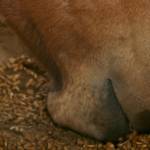When He Doesn’t Eat Like a Horse: Dealing with the Picky Eater

An average horse weighs around 1,100 lb (500 kg). It takes a lot of food to keep him growing, training, performing, or carrying out whatever work he is doing, and most horses are eager to chow down on whatever they are served. But what if your horse just won’t touch what you’re offering? How can you figure out how to tempt his appetite, keep him properly nourished, and prevent weight loss? Identifying the problem and then correcting it can be a challenge.
As a first step, look at the horse’s overall diet. Most horses will eat grass and legumes in the field even if they turn up their noses at grain products. For many horses, this forage may meet all nutritional needs so that owners don’t really need to add grain meals. If a horse grazes, seems healthy otherwise, and is not losing weight, he might be doing fine. On the other hand, if he’s always accepted grain and suddenly won’t touch it, there may be a problem that could be uncovered by a veterinarian.
Horses that are working hard will probably need the calories provided by grain, and these are often the very equines that back away after only a bite or two of sweet feed or pellets. If this is the case, the animal may fit a common scenario in which an exercising horse needs more energy, is fed large grain meals, develops gastric ulceration or an acidic digestive tract because of the grain overload, and begins to back off his feed due to abdominal discomfort. Hindgut acidosis is a relatively common condition in horses that are fed a lot of grain, but adding an ulcer medication or a digestive tract conditioner can ease or prevent pain and get the horse back on track.
Another reason horses refuse feed is because of discomfort when they chew. Broken teeth, overgrown points, or sharp edges can be corrected by a veterinarian or equine dentist. Once this is done, many horses will happily go back to gobbling up their grain.
Besides oral or abdominal pain, discomfort in other areas can make horses so stressed that they may stop eating. Laminitis, arthritis, injuries, or complications from surgery may cause enough pain that the horse just can’t focus on eating. A veterinarian may be able to find and treat the cause of this sort of acute or chronic pain.
Social stress—being alone, losing a best friend, or being bullied by another horse—can lead to temporary disinterest in feed. Simply moving the horse into another group or providing a buddy (another pony or horse, goat, cow) may make a big difference and get the horse eating again.
Horses are creatures of habit. Thus, any change can throw a horse off its feed. Introducing a new product or feed form should be done over a period of several days, mixing a little of the new product into the current ration at the first feeding and then increasing the proportion until the horse is eating the new feed. The same goes for adding oil, rice bran, or a supplement: begin with just a small amount and increase very gradually. This schedule also allows the horse’s digestive tract to adapt to the new feed, preventing upsets.
Even if you’re offering the same feed the horse has always eaten, he may refuse it for a number of reasons. It might have changed a bit in formulation or ingredient source, or it may be slightly rancid or moldy. The horse will be able to tell, even if you can’t detect any variation in odor or appearance. If the horse is being fed in a different stall, or out of a different bucket, or from the same bucket that has been moved to a different corner of the stall, or at a different time of day, or using feed that has been stored in a different container (maybe a new plastic storage can rather than the old metal one), your horse may focus only on “different” and refuse to eat, at least at first. This dependence on habit is a good reason to be sure you don’t run completely out of one batch of feed before starting another; mixing new and old will help to ease the transition.
Some horses don’t fit into any of these categories; they’re just always picky about what they eat for no reason anyone can figure out. Owners can try feeding small amounts more often; mixing a little molasses or applesauce or yogurt into the feed; hand-feeding a few bites before filling the feeder (is the feeder clean, or could it have an “off” smell from dirt or mold?); adding some chopped, dampened alfalfa hay into the feed; or feeding the grain by pouring it onto hay in the stall or field rather than using a bucket or feeder. If a supplement has been added, try offering the feed without this addition. If you’re feeding a grain mix, give straight oats a chance (and then gradually add a balancer pellet to ensure nutrient requirements are met).
If these methods don’t get the horse eating grain, and a veterinarian has examined the horse and found no physical reason for its refusal, the owner may have to accept the fact that the horse just doesn’t have a taste for grain. Odd as it may seem, some horses may simply prefer grass and hay to any sort of concentrate, though this is rare. As long as the horse is healthy and energetic, his choice may have to be accepted, at least in the short term. Waiting a week or two and offering grain again just might change his mind!








